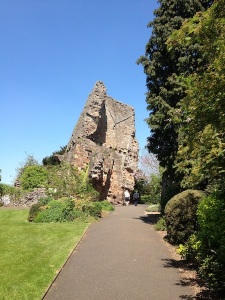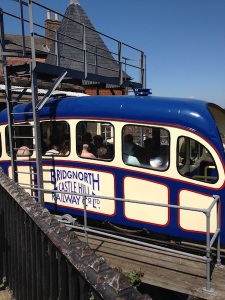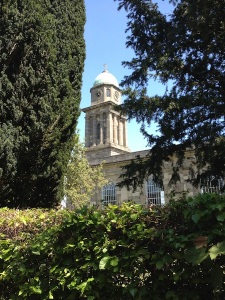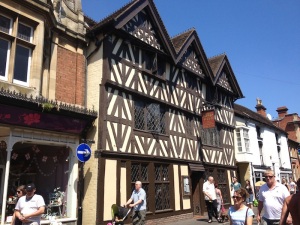Having found myself without plans for Saturday daytime and faced with the risk of a wasted sunny day, I decided to take a little trip to Bridgnorth. Being an overly shy person, doing such things alone is no easy feat.
Bridgnorth is a small Shropshire town on the River Severn, which is split into two; High Town and Low Town.


Like Ironbridge, Bridgnorth is named after a bridge across the River Severn. The first reference of a settlement at Bridgnorth dates back to 895 however the town was not created until 1101 when a castle and church was built on the site of the modern-day town.
Low Town was once a thriving river port, whilst High Town consisted of the castle, churches and many 16th and 17th century buildings, many of which still exist today.
Bridgnorth Castle

The castle at Bridgnorth located in High Town, consisted of a square tower and castle walls. It was founded in 1101 and during the English Civil War was one of the main Royalist strongholds for the West Midland area. Following a three-week siege, Cromwell’s forces succeeded in capturing the castle, after which Cromwell ordered its destruction. Nowadays little is left of the castle, much of the stone from the castle was used to repair other damaged buildings in Bridgnorth. Only a small section of the tower remains, which leans at an angle of 15 degrees.

Next to the Castle is the Anglican Church of St. Mary Magdalene and further down the road, the Town Centre.
Town Hall

Bridgnorth’s timber-framed Town Hall located on the High Street was built in 1652, constructed from a redundant tithe barn donated by a resident of Much Wenlock.
The building features stain-glass windows depicting English monarchs and is adorned with a Victorian coat of arms on each end. There is a market space beneath the Town Hall, with stairs up to the council chambers. Nowadays, the Town Hall displays information about the town’s history and houses a tea room.
St Leonard’s Church

I hadn’t been to St. Leonard’s Church before, nor had I ever seen it, I accidentally happened upon it whilst taking a photo of one of the pretty old buildings.
St Leonard’s Church is a redundant Anglican church under the care of the Churches Conservation Trust. The Church originates from the 12th Century and a tower added in 1448. During the Civil War, large sections of the church were destroyed after shot from a cannon ignited ammunition being stored by the Roundheads in the north aisle. Following various repairs, the church underwent a major reconstruction in 1860, however by the 1970’s the tower was declared unsafe resulting in its closure in 1976. Following it’s closure the church has been repaired and maintained by the Churches Conservation Trust since 1980.

As I was taking the photo above, a gentleman told me to walk closer to get a better photo. He then sat at the organ and began to play, stopping momentarily to ask whether I played. I said no of course, even if I could I would be far too scared to play a church organ. I was able to get a quick video of the man playing before leaving.
After leaving the church and sitting on the grass for a rest, I headed back through the town.
Cliff Railway

Like Aberystwyth’s Cliff Railway, the Bridgnorth Cliff Railway (also known as Castle Hill Railway) is a funicular railway, that is, a cable attached to two trams; one at the top, one at the bottom counterbalancing each other, allowing the trams to travel up/down a steep hill. The Bridgnorth Cliff Railway is one of the steepest funicular railways in the UK, and the shortest.

The Cliff Railway at Bridgnorth was constructed as a result of a town meeting in 1890, to discuss the need for an alternative method of communication and transport between High and Low Town. Building commenced in 1891 and the railway opened the following year. Again, like Aberystwyth’s Cliff Railway, the Bridgnorth Cliff Railway was originally powered by water, the move to electricity occurred between 1943 and 1944.

I did not travel on the Cliff Railway at Bridgnorth this time, having done so many times as a child, I chose instead, to walk down the steep steps adjacent to the railway.
Theatre on the Steps
As you walk down the steps next to the Cliff Railway, you will pass the Theatre on the Steps.

I’ve never seen anything quite like it before, these are a narrow set of steps, there are bushes on the other side of the steps and the occasional back or side of a house, and yet there is a theatre on them.
The Theatre originally built as a Congregational Church, was built on the site of an earlier church constructed in 1709 following the introduction of Freedom of Worship. This Presbyterian Chapel, later Congregational Church, was demolished in 1829 having fallen into disrepair due to a dwindling congregation and unpopular minister. The new chapel was in use from 1829 until 1962 when three Bridgnorth chapels merged forming the United Reformed Church and began worshipping in Cartway Church; a short walk around the corner from the High Town Cliff Railway entrance.
The chapel was put on the market in 1960 and was purchased in 1962 by a company of amateur actors and townspeople. After the purchase, the dramatics company began requisitioning lights, curtains and seats and removed the pulpit and pews, before the theatre was ready to open.
The theatre is still open today and following an extensive refurbishment in 2002, including the building of a balcony, plays and concerts are performed to 180 people, 40 weeks of the year.
Low Town Caves

During the Civil War, Bridgnorth as I have said, was a key Royalist stronghold for the Midlands. The castle was under siege for three weeks in 1642, during which time Colonel Lavington thought up the idea of tunnelling under High Town, with the aim of igniting the Royalist’s ammunition stored in the Church of St. Mary Magdalene. The Royalists, concerned the cliff would collapse, surrendered when the tunnellers had excavated a 70 foot tunnel. The series of tunnels and would-be tunnels, named “Lavington’s Hole” are still visible today however they have had bars erected to prevent access to them due to a number of collapses, including a recent collapse resulting in the death of a youth who was camping there.


Other Photos
Here are a selection of photos from my afternoon in Bridgnorth:-






Eurovision Evening
After my Bridgnorth excursion, I rushed to the supermarket for ingredients then prepared for my on/off (due to indecisive grandparents) Eurovision evening with Jessicca and Marion. Homemade BBQ chicken and Vegetable pizza’s were on the menu along with homemade chocolate brownies, store-bought quiche, salad and tortilla chips (with dip) and some wine. I don’t get to play the host very often but when I do, I do it well, I have no doubt that neither Emma nor indeed Mrs Elton could find fault.



Having spent all afternoon walking around Shrewsbury in the sun (a blog post for another day), I shall now retire and get lost in Austen, before the start of another working week.


One Reply to “”